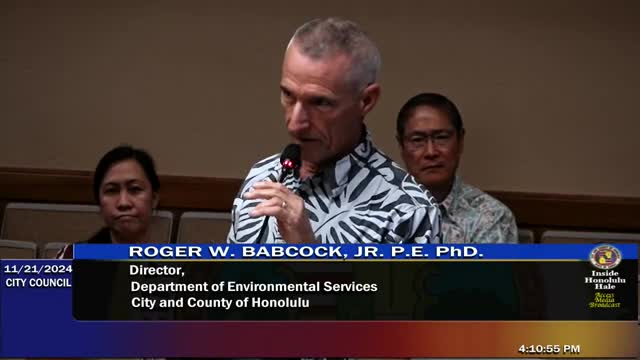Wastewater treatment crisis demands urgent public awareness
November 22, 2024 | Honolulu City, Honolulu County, Hawaii
This article was created by AI summarizing key points discussed. AI makes mistakes, so for full details and context, please refer to the video of the full meeting. Please report any errors so we can fix them. Report an error »

During a recent government meeting, officials discussed critical updates regarding wastewater management, highlighting the importance of treatment processes and the need for increased sewer fees. A visual presentation showcased jars of wastewater, illustrating the differences between untreated, primary treated, and secondary treated wastewater. The samples were sourced from two key facilities: Honouliuli in Ewa Beach and the Sand Island Wastewater Treatment Plant.
The Sand Island facility currently only provides primary treatment, which means that untreated wastewater is released into the ocean after minimal processing. This situation underscores the urgency of upgrading to secondary treatment, a significant project that is a central reason for the proposed increase in sewer fees. Officials emphasized the environmental implications of inadequate wastewater treatment and the necessity of public cooperation in maintaining the integrity of the sewer system.
In an effort to educate the public, officials reiterated that toilets should only be used for human waste and toilet paper, while fats, oils, and grease should be disposed of properly to prevent clogging the sewer system. Instead of entering the wastewater stream, these materials should be sent to H-Power, where they can be converted into electricity.
The meeting served as a platform to raise awareness about the challenges facing wastewater management and the critical steps needed to enhance treatment processes for environmental protection and public health.
The Sand Island facility currently only provides primary treatment, which means that untreated wastewater is released into the ocean after minimal processing. This situation underscores the urgency of upgrading to secondary treatment, a significant project that is a central reason for the proposed increase in sewer fees. Officials emphasized the environmental implications of inadequate wastewater treatment and the necessity of public cooperation in maintaining the integrity of the sewer system.
In an effort to educate the public, officials reiterated that toilets should only be used for human waste and toilet paper, while fats, oils, and grease should be disposed of properly to prevent clogging the sewer system. Instead of entering the wastewater stream, these materials should be sent to H-Power, where they can be converted into electricity.
The meeting served as a platform to raise awareness about the challenges facing wastewater management and the critical steps needed to enhance treatment processes for environmental protection and public health.
View full meeting
This article is based on a recent meeting—watch the full video and explore the complete transcript for deeper insights into the discussion.
View full meeting
